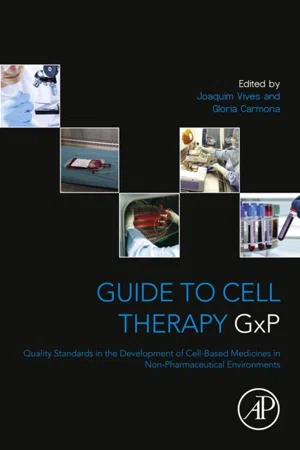
Guide to Cell Therapy GxP
Quality Standards in the Development of Cell-Based Medicines in Non-pharmaceutical Environments
- 266 pages
- English
- ePUB (mobile friendly)
- Available on iOS & Android
Guide to Cell Therapy GxP
Quality Standards in the Development of Cell-Based Medicines in Non-pharmaceutical Environments
About This Book
Guide to Cell Therapy GxP is a practical guide to the implementation of quality assurance systems for the successful performance of all cell-based clinical trials. The book covers all information that needs to be included in investigational medicinal product dossier (IMPD), the launching point for any clinical investigation, and beyond. Guide to Cell Therapy GxP bridges a knowledge gap with the inclusion of examples of design of GLP-compliant preclinical studies; design of bioprocesses for autologous/allogeneic therapies; and instruction on how to implement GLP/GMP standards in centers accredited with other quality assurance standards. Guide to Cell Therapy GxP is an essential resource for scientists and researchers in hospitals, transfusion centers, tissue banks, and other research institutes who may not be familiar with the good scientific practice regulations that were originally designed for product development in corporate environments. This book is also a thorough resource for PhD students, Post-docs, Principal Investigators, Quality Assurance Units, and Government Inspectors who want to learn more about how quality standards are implemented in public institutions developing cell-based products.
- Easy access to important information on current regulations, state-of-the-art techniques, and recent advances otherwise scattered on various funding websites, within conference proceedings, or maintained in local knowledge
- Features protocols, techniques for trouble-shooting common problems, and an explanation of the advantages and limitations of a technique in generating conclusive data
- Includes practical examples of successful implementation of quality standards
Frequently asked questions
Information
Overview of the Development Program of a Cell-Based Medicine
Abstract
Keywords
Advanced therapy medicinal product; Cell-based medicine; Licensing; Product development; Product lifecycle; Target product profile1. Introduction
| Name; Description | Manufacture |
| In the United States: | |
| Provenge®; Autologous cellular immunotherapy | Dendreon Corporation |
| Laviv®; Autologous cultured fibroblasts | Fibrocell Technologies, Inc. |
| Carticel®; Autologous cultured chondrocytes | Genzyme BioSurgery |
| Gintuit®; Allogeneic cultured keratinocytes and fibroblasts in bovine collagen | Organogenesis, Inc. |
| Allocord®; HPC from cord blood | SSM Cardinal Glennon Children’s Medical Center |
| Hemacord®; Allogeneic HPC from cord blood | New York Blood Center |
| Ducord®; HPC from cord blood | Duke University School of Medicine |
| HPC from cord blood | Clinimmune Labs, University of Colorado Cord Blood Bank |
| HPC from cord blood | LifeSouth Community Blood Centers, Inc. |
| In Europe: | |
| Chondrocelect®; Autologous cultured chondrocytes | TIGenix |
| MACI®; matrix-induced autologous chondrocyte implantation | Genzyme |
| Provenge®; Autologous cellular immunotherapy | Dendreon Corporation |
| Holoclar®; Autologous limbal stem cells | Chiesi Farmaceutici S.p.A. |
| In Canada and New Zealand [12]: | |
| Prochymal®; Adult human MSC | Osiris Therapeutics, Inc. |
| In Japan [12]: | |
| JACE®; Autologous cultured epidermis | Japan Tissue Engineering Company (J-TEC) |
| JACC®; Autologous cultured cartilage | Japan Tissue Engineering Company (J-TEC) |
| In Korea [12]: | |
| Hearticellgram-AMI®; Autologous bone marrow-derived MSC | Pharmicell |
| Cartistem®; MSC for the treatment of osteoarthritis | Medipost |
Table of contents
- Cover image
- Title page
- Table of Contents
- Copyright
- List of Contributors
- Foreword
- Preface
- 1. Overview of the Development Program of a Cell-Based Medicine
- 2. European Regulatory Framework for the Development of Cell-Based Medicines
- 3. Nonclinical Studies for Cell-Based Medicines
- 4. Good Manufacturing Practice Compliance in the Manufacture of Cell-Based Medicines
- 5. Good Clinical Practice in Nonprofit Institutions
- 6. Compatibility of GxP with Existing Cell Therapy Quality Standards
- Index
